by Donna Birkey
The recent explosion of interest in needlework surely invites today’s doll costumer to follow the lead of their Victorian predecessors and add some fancy handwork to a doll dress or slip in a favorite old-time stitch or two. The basic stitches are rather simple. Just a bit of time will add flair to an otherwise plain garment and you’ll be pleased with the results of your efforts.
In the Victorian era, ethnic styles seemed to display more handwork than most other doll clothes, with German-style clothes running second. Couture French clothes depended more on lace, trims, and complicated sewing techniques than on handwork stitches for their uniqueness.
Resource books, auction catalogs and actual vintage doll clothes generally indicate the most common handwork stitches used from about 1865 to 1925 were the chain stitch, feather stitch, herringbone stitch, fagotting or hem stitch, running stitch, blanket or buttonhole stitch, and cross stitch.
To keep your costume authentic, work stitches only on 100 percent cotton, linen, wool, or silk (thin silk may need a backing). Most of the time your stitching will look best on a very plain background, However, note how the embroidery on the belt in the photo below blends with the print of the fabric.
Certain colors are more appropriate than others. White and black backgrounds are fine for any fashion era, but they are by no means the only colors you can use. Usually safe are any of the primary colors in the softer tones. Be sure to steer clear of modern fluorescents! Use colors for your stitches that blend or contrast well with the fabric you choose. A color wheel will give you help if you are unsure of your own judgment.
Happy stitching!
Stem and Lazy Daisy Stitch
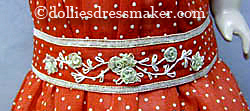 Simple stem and lazy daisy stitches used with fabric flowers dress up an otherwise uninteresting polka dot vintage cotton sash. The vintage edge trim was attached to the sash by hand.
Simple stem and lazy daisy stitches used with fabric flowers dress up an otherwise uninteresting polka dot vintage cotton sash. The vintage edge trim was attached to the sash by hand.
Feather Stitch
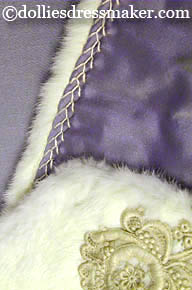 Feather stitch used around the edge of the lining side of a fur stole.
Feather stitch used around the edge of the lining side of a fur stole.
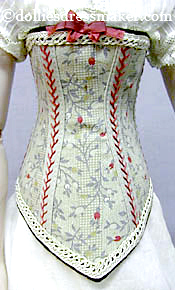 More feather stitching on a boned corset made from vintage fabrics.
More feather stitching on a boned corset made from vintage fabrics.
Blanket or Buttonhole Stitch
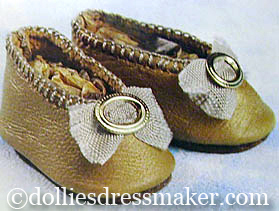 The shoes are edged with the blanket or buttonhole stitch with #12 DMC Perle Coton in a blending color.
The shoes are edged with the blanket or buttonhole stitch with #12 DMC Perle Coton in a blending color.
Fagotting and Cross Stitch
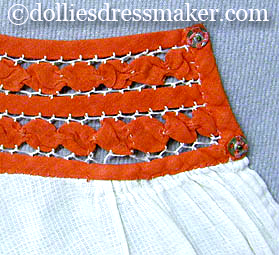 A vintage dress of lightweight cotton pique with yoke of bias strips (alternated flat and puffed) attached together with fagotting. On the skirt of the dress are elephants done in cross stitch. The dress was picked up at an estate sale.
A vintage dress of lightweight cotton pique with yoke of bias strips (alternated flat and puffed) attached together with fagotting. On the skirt of the dress are elephants done in cross stitch. The dress was picked up at an estate sale.
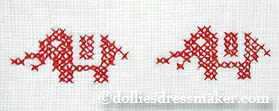 A similar garment – a fagotted apron–adapted from an 1880s antique pattern by Hazel Ulseth was presented with directions in the Feb-Mar 1994 issue of the Doll Costumer’s Guild Newsletter.
A similar garment – a fagotted apron–adapted from an 1880s antique pattern by Hazel Ulseth was presented with directions in the Feb-Mar 1994 issue of the Doll Costumer’s Guild Newsletter.
Stitch Samples
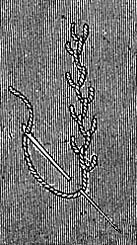
Featherstitch
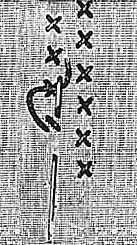
Cross Stitch
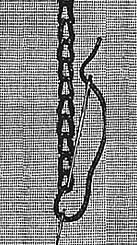
Chain Stitch
Modern threads which can be authentically and effectively used:
-
- DMC Perle Coton…Size 5, 8, or 12
- DMC Cebelia (cotton)…Size 30
- Candle Wick Yarn (cotton)
- Four-strand (one or two strands at a time)
- Froehlich Swiss Wolle (Special)…A very fine wool thread
- Silk Embroidery Floss…Six-strand (one or two strands at a time)
- Cotton Embroidery Floss…Six-strand (one or two strands at a time)
All of the above are available at most yarn or handiwork stores.
I’ve not found a mail order supplier for the Froehlich wool. Also, keep your eyes open for old mending wool and cotton crochet thread in resale shops or at estate sales.
| STITCH | USES | MATERIALS |
| Simple Chain Stitch | One of the most ancient stitches, worked straight or in a design, usually used as an outline. Outline edge of a wool jacket or coat collar. | Silk or cotton floss or thin wool yarn. When used on lightweight fabric such as batiste, choose a fine thread (size 50). |
| Herringbone Stitch | Along a hem line, trim a bias neck binding. | Silk or cotton floss |
| Feather Stitch | Most often used is the double feather stitch. On a corset/stole, around cape edge, flannel petticoat, neck and arm edges, bands on drawers. | Silk or cotton floss |
| Blanket or Buttonhole Stitch | Sleeveless jacket edges and armholes, flannel petticoat, edge a shoe. | Silk or cotton floss |
| Running Stitch | Edge a collar. Looks nicer on fabric with more substance, such as wool. | Silk or cotton floss or thin wool yarn |
| Stem and Lazy Daisy Stitches | Can be applied as a belt or collar decoration. | Silk or cotton floss |
| Fagotting Stitch | A kind of hemstitch with wide spaces. Makes a nice yoke. | Cotton thread |
| Cross Stitch | A very familiar stitch. See photo above for simple decoration on dress. Or collar and cuffs. | Silk or cotton floss |
There are many excellent instructional books and magazines that show and explain the procedures for making the individual stitches discussed here.
Bibliography
For comprehensive illustrations and explanations of Victorian stitches:
Encyclopedia of Victorian Needlework (Dictionary of Needlework) by S.F.A. Caulfeild, in two volumes, published by Dover Publications, Inc., NY. Copyright © 1972. (Unabridged republication of the second edition (1887) of the work originally published by A.W. Cowan, London, in 1882.)
For modernized uses of some of the old stitches:
Elegant Stitches, Copyright © 1995 by Judith Baker Montano, published by C&T Publishing, Lafayette, CA 94549
For studying antique and antique reproduction doll costumes:
The Collector’s Book of Doll Clothes, by Dorothy S. Coleman, (Evelyn J. and Elizabeth A.) Copyright © 1975. Published by Crown Publishers, Inc., 419 Park Ave. S., NY 10016
Article published in September 1996 issue of DOLL CRAFTER magazine published by Scott Advertising and Publishing Co.
